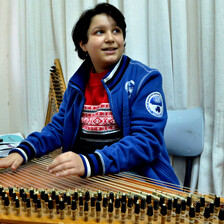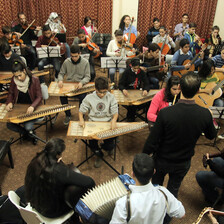The Electronic Intifada 2 September 2021
When the 22-year-old first joined the Edward Said National Conservatory of Music in Gaza City, she wanted to learn how to play the piano. But she had no luck with registration.
She then opted for the oud, a traditional Middle Eastern stringed instrument similar to the lute.
“I had trouble because I am left-handed and playing is done with the right hand. That was constraining,” al-Jorf told The Electronic Intifada.
The Edward Said National Conservatory of Music was established in the occupied West Bank city of Ramallah in 1993, and later opened branches in Nablus, Bethlehem and Hebron, as well as Gaza City.
The Gaza branch has 125 students, aged 7 to 22 years old, Khamis Abu Shaban, an administrative assistant at the conservatory, told The Electronic Intifada.
Israel’s draconian siege on the coastal enclave, now in its 14th year, affects students and instructors alike.
The siege makes it harder for students to take part in concerts abroad and for instructors to travel to other branches. Bringing musical instruments into the Strip is also hampered by the blockade.
And the impact of the Israeli siege on the economy affects students’ ability to learn how to play music.
With one of the highest unemployment rates in the world and more than half the population living below the poverty line, it is hard for families in Gaza to afford music lessons for their children.
Mahmoud Abu Hamad, a 16-year-old student at the conservatory, is learning how to play the goblet drum.
“The goblet drum can be a beautiful instrument – as I played it I grew to love it,” he told The Electronic Intifada. “I’ve made new friends and we jam together.”
Note: The footage in this video was shot before Israel’s 11-day bombing campaign on the Gaza Strip in May.
The Edward Said National Conservatory of Music was not damaged and none of the interviewees were injured.
Video by Ruwaida Amer and Sanad Ltefa.


